All about the Samoyeds

The spectacular appearance and friendly disposition of Samoyed Laikas (or, as they are also called, Samoyeds or Arctic Spitz) are able to touch and touch absolutely any person. Even at the dawn of the emergence of the Samoyed breed, they were used mainly as sled and hunting dogs capable of covering considerable distances in a harsh climate. To our days, Samoyed Laikas are increasingly being raised as companion dogs, able to brighten up the leisure of their owner and his family members.

Description
This breed is considered one of the oldest, since the history of its origin dates back to the 11th century BC. The birthplace of the breed is considered to be the north of Russia (Siberia).
Initially, dogs of this breed were bred by small northern tribes (Samoyedians), who were the ancestors of the modern Nenets, Selkups, Enets, Nganasans. Since all representatives of these tribes kept dogs of the same type, the researchers suggested that at a certain time the Samoyeds managed to domesticate the white wolf. The indigenous inhabitants of the North used these dogs as hunting dogs, less often as sled dogs. In addition, they were used by the Samoyedians both as herding dogs, helping reindeer breeders, and even as nurse dogs.

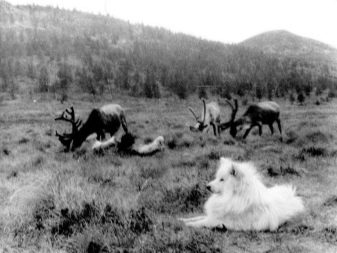
The friendly disposition of the Samoyeds to this day allows them to get along well and find a common language with the smallest members of the family.
Samoyed Laikas helped the nomadic tribes to survive the harsh polar nights. For this purpose, at nightfall, the dogs were herded into dwellings, where they slept, embracing them.
There are curious versions explaining the origin of the name of this breed. It is believed that it goes back to the collective name of the northern tribes - Samoyeds (another name - Samoyeds). According to another version, not officially confirmed, but having a completely logical justification, the name of the breed is associated with the fact that when these dogs were harnessed to the sled, the animals merged with the snow-covered road. In the dark, the impression was created that the sleds were moving by themselves, which is why they began to be called Samoyeds (that is, from the phrase “they go by themselves”). Later this name was assigned to the breed.
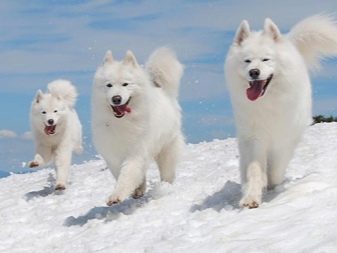

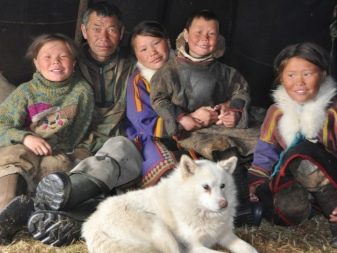
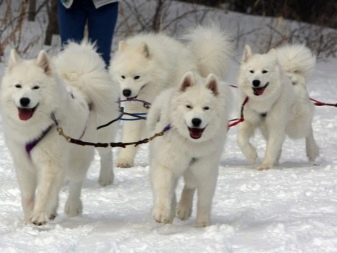
Characteristics and features of the breed
Samoyeds, also called Samoyed Spitz, are of medium size. The height at the withers can range from 50 to 60 centimeters (depending on the gender and individual characteristics of the animal). Weight indicators range from 15 to 30 kilograms.
The appearance of this breed is very impressive. The Samoyeds literally radiate confidence, power, strength, charm and nobility. Dog handlers and professional breeders of Samoyed Spitz argue that the owner of such a dog will never go unnoticed by others.
The Samoyed's muzzle is very expressive. Slightly slanted eyes and rising corners of the mouth give the impression that the animal is smiling.
These dogs have a large and powerful head in proportion to the body. The triangular ears are set wide apart, slightly rounded at the tips. Samoyed ears should be erect and symmetrical.
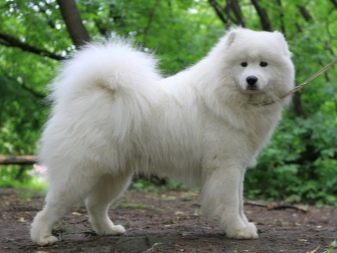
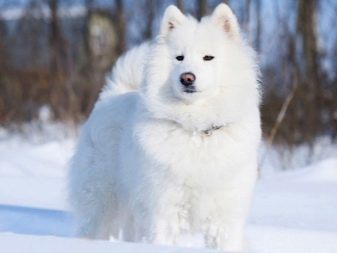


The muzzle of the Samoyed Laikas is neat, slightly tapering towards the nose. Scissor bite, lips tightly closed, black. The nose should be black, but in some cases (for example, in spring or winter) hypopigmentation is acceptable, in which brownish-pink spots form on the nose. However, even when discoloration of the lobe, its border should remain black.
The Samoyed's eyes are dark brown, small, with a dark brown edging. Heterochromia and blue eye color are commonly referred to as serious, critical flaws.
The neck of the Samoyed Laikas is powerful and strong, with a slight bend. The body is compact, in length slightly exceeding the height of the animal at the withers. The back is moderately elongated, has a well-defined withers and a strong, strong loin. The body of the Samoyeds is muscular and strong, well-built.
Both the hind and front legs of the Samoyed Laikas are strong and even, with pronounced and well-developed muscles. The fingers are not very tightly closed.
The tail is set high enough. When the dog is agitated, his tail can take the shape of a half-ring, dropping on his back or to one side.
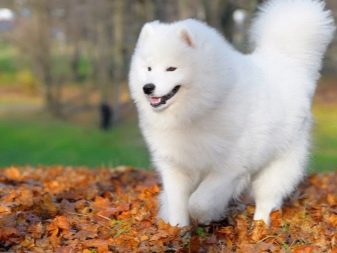
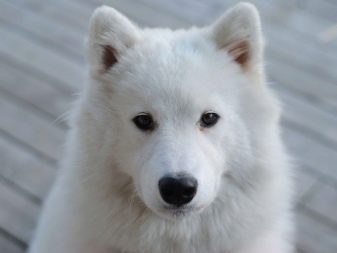


The coat is very thick, dense and shiny. The coat is formed from a short undercoat and long guard hairs.
A unique feature of Samoyed wool is the ability to clean itself. Thanks to her, dogs of this breed do not need frequent bathing.
The breed standard provides for a snow-white or cream-colored coat. Also acceptable is a white color with a few biscuit areas. The color of the coat is light brown.
Samoyeds do not have any other colors, except for those provided for by the breed standard. Many inexperienced dog breeders often mistake for the black Samoyed Laikas a separate species of Northern Spitz - the Swedish Lapphund. Both in physique and in habits, both of these breeds are very similar. However, the color of the dogs of these breeds is different: snow-white for the Samoyeds, black for the Lapphund.
The average lifespan of Samoyed Laikas varies from 12 to 15 years. As practical observations show, Samoyed males live somewhat longer than bitches. So, the life expectancy of males is about 14-15 years, bitches - 13-14 years. With proper care and adherence to all recommendations for maintenance, the life of a dog can reach 17-20 years.
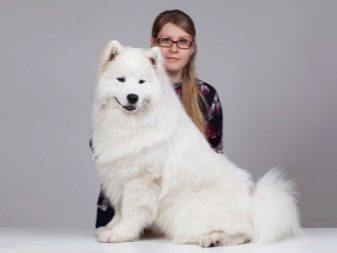
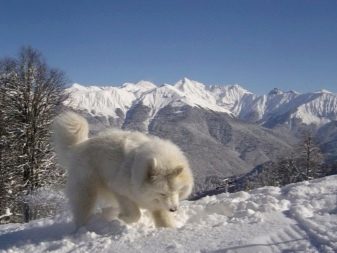
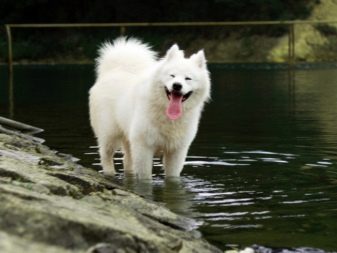

Pros and cons of the breed
Before purchasing a dog of this breed, you should carefully familiarize yourself with its features, advantages and disadvantages. Experienced owners of Samoyed Laikas do not recommend having such dogs, being impressed exclusively by their spectacular exterior and good-natured disposition. Like any other animal, Samoyeds have their own specific pros and cons.
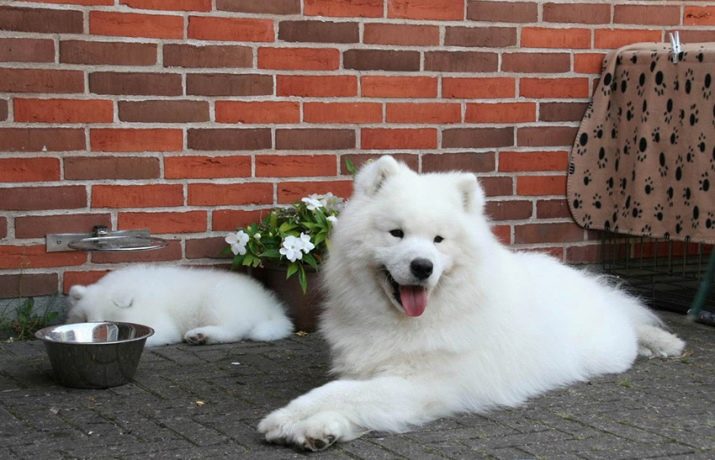
So, not only their luxurious appearance, but also:
- friendly character;
- friendly attitude towards children;
- good health;
- endurance.
Breeders of dogs of this breed argue that Samoyeds, with increased mobility and energy, do not let their owners get bored. It is important to consider this aspect for those people who prefer calm and measured leisure.
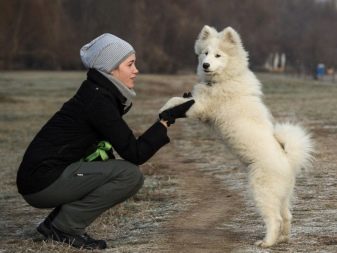
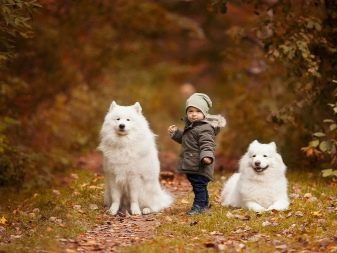
In this case, before buying a pet, you should carefully evaluate your capabilities and the amount of time that you plan to devote to the pet in the future.
The relative disadvantages of dogs of this breed, in turn, include such as:
- tendency to dominate;
- tendency to stubbornness, disobedience;
- tendency to vagrancy;
- intolerance to loneliness;
- the need for regular grooming of the coat.
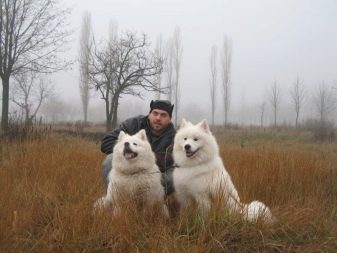
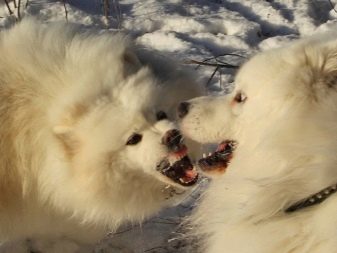
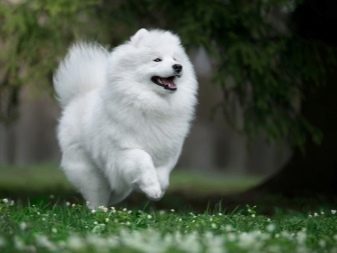
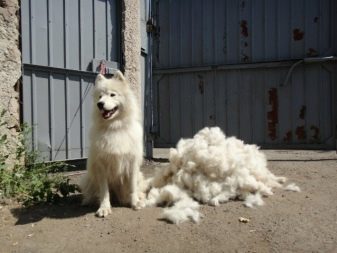
Left alone, the Samoyed is able to spoil things and furniture, thereby expressing longing for the owner. As a companion dog, it needs the increased attention of its owner.
However, the contradictory nature of this animal often manifests itself in attempts to dominate the owner. Such behavior must be suppressed, and this, in turn, requires the owner of the dog to have the skills to properly handle the animals.
Another specific nuance in the content of the Samoyed is that this breed has poorly expressed protective qualities. Planting a Samoyed Laika to guard the house, the owner of the animal usually does not get the desired result.
It should also be borne in mind that the Siberian origin of this breed determines the corresponding structure and specific features of the dog's coat... Samoyed huskies usually molt once a year, but this process takes up to 3 weeks. In order for the dog to look neat during the moulting period, the owner will have to devote a sufficient amount of time to combing the pet. Washing the Samoyed and subsequent drying of the wool is a lot of trouble. However, here it should also be noted that the wool of these animals practically does not accumulate in itself an unpleasant odor - what in everyday life is called "dog".
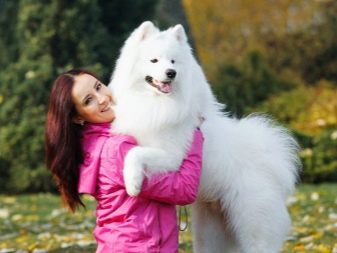

Varieties
Despite the fact that the history of the origin of this breed is more than 3 thousand years old, professional cynological communities by historical standards have become interested in it relatively recently. For this reason in each country began to emerge and improve their own breed standards, of which today there are 7.

There is also another classification of the Samoyed species, proposed by the British zoologist Ernst Scott. Within the framework of this classification, the division of dogs into types is provided based on the features of the structure of their skull. In accordance with this classification, it is customary to distinguish the following types of Samoyed huskies:
- bearish;
- wolfish;
- fox.
Representatives of the bear type are distinguished by their massive and powerful build, large heavy head, short and wide muzzle. The wolf type, in turn, is characterized by a thinner and leaner body, an elongated head and a slightly elongated muzzle. The fox type is characterized by a thin build, a narrow muzzle, slightly larger and slanting eyes (in contrast to the previous types).
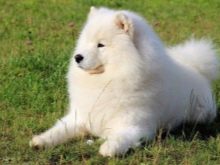


Character traits
Dogs of this breed have a very bright, playful, friendly, but at the same time contradictory character. Some representatives of this breed often show willfulness, strive to win a dominant position in the "owner-dog" ligament.
In the absence of proper education and control on the part of the owner, an overly inquisitive and playful Samoyed is able to escape, being on a free range. For this reason, experienced breeders recommend from the very first days of purchasing a puppy to devote a sufficient amount of time to correct and correct upbringing of a pet.
As practice shows, Samoyed huskies get along well with children, show increased attention to them and even try to take care of them. The potential of this breed actually allows, with a competent approach, to raise a conscientious nanny, a reliable friend and companion for children from a pet.
Samoyeds are hyperactive animals that need regular intense exercise. They are distrustful of strangers, but they do not show aggression.
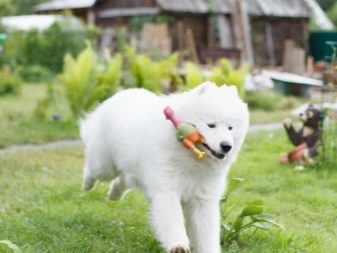
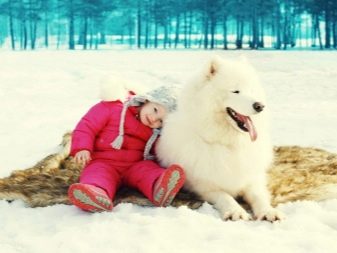
Experienced breeders claim that the gentle nature of these dogs allows them to easily get along with other animals.
How to choose?
When planning to get a Samoyed Spitz, you should decide on the purpose of acquiring a pet. If a potential owner expects to buy a puppy in order to further participate in exhibitions, it is necessary to pay special attention to the pedigree of the animal. In addition, even at the stage of selection, it is important to exclude any possible defects that may later lead to the disqualification of the dog. An important role is played by the exhibition potential of the puppy, inherited from his parents. It is preferable that the parents have a successful experience of participation in exhibitions, have the appropriate awards and titles.
Professional breeders recommend that you carefully read the breed standard before purchasing a puppy. If the dog is purchased not for shows, but for the home and "for the soul", minor deviations from the standard can be considered uncritical. A more important condition is the baby's health status, the absence of genetic or chronic diseases.
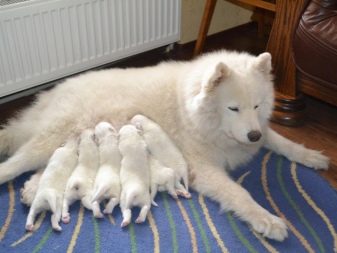
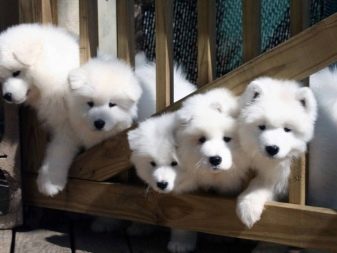
Given this condition, it is necessary to apply for the purchase of a future pet only to a reliable and conscientious seller (kennel or club) with a good reputation among breeders and owners of Samoyeds.
Visually, the puppy should not look sick or weak. The coat should be clean and shiny. Scratches, bald spots, traces of skin parasite activity should not be visible on the puppy's body. The color must correspond to the breed standard.
The skin of healthy puppies is pinkish, clean, without spots, pimples, growths and strange formations. Ears and eyes should be clean and free of any traces of discharge.
The puppy should not emit an unpleasant odor, which is often indicative of infectious diseases or endocrine disorders. Also, an unpleasant odor emanating from an animal can indicate serious digestive problems, as well as diseases of the gastrointestinal tract.

During the examination, you must feel the puppy. His belly should be tight, but not bloated. A swollen belly in combination with a dull matted coat indicates that the animal is infected with helminths.
Healthy puppies are characterized by mobility, activity, curiosity. They willingly make contact, show interest in a stranger. Aggression or cowardice testifies to the unstable psyche of the animal, therefore it is undesirable to acquire such puppies.
The puppy's gait should be assessed. When moving, the animal should not roll over to the sides or limp. Gait disorders are often indicative of joint problems or musculoskeletal disorders.
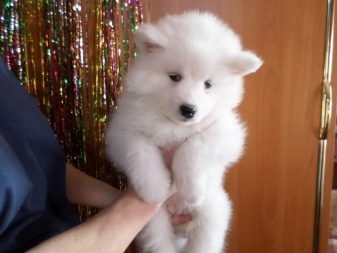
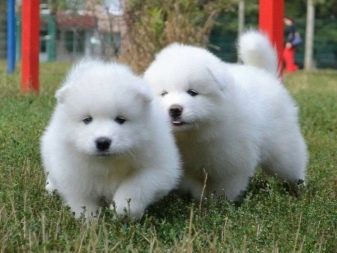
Both the hind and the front legs of the puppy should be straight and symmetrical, the pads should be black and firm. Dewclaws should be removed. The tail can be lowered if the animal is calm. If the puppy is agitated, its tail should be slung over its back and down to one side.
When purchasing a boy puppy, you need to gently feel its scrotum. Both testes should be omitted. Cryptorchidism (undescended testicles into the scrotum) is considered a serious malformation.
The ears should be small, triangular. They usually get up in Samoyed puppies at 4-5 months of age.
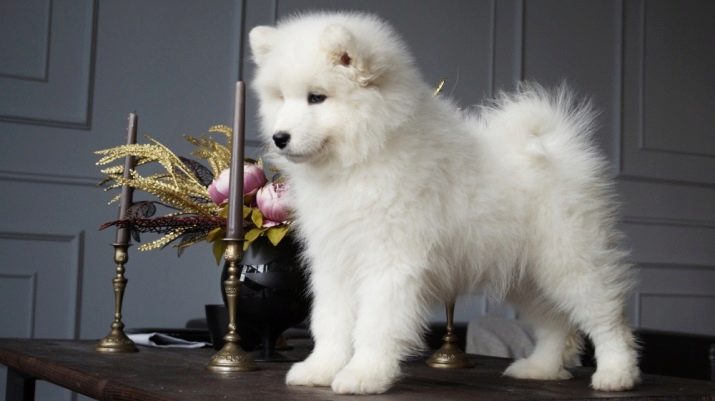
It is important to make sure that the package of necessary documents is attached to the puppy. It must include a special puppy card with all the data and the stamp of the club (kennel), a veterinary passport, as well as a contract for the sale of an animal.
How to name?
In choosing a suitable nickname for a Samoyed Laika puppy, you can focus on both its external features and character. As quite popular variants of names, such as Sunny, Sammi (another name for the Samoyeds), Whitey, Belka (Belek, Belyash), Snezhok (Snezhka, Snezhinka), Suga (Sugar), Snowy, Snow can be cited here. Other common variants of names are Blank (Bianca, Blanca), Alba (Albert, Albo), Salt, Zephyr, Pearl, Ice, Frosey, Cloud, Angie (Angel), Crystal (Christa).
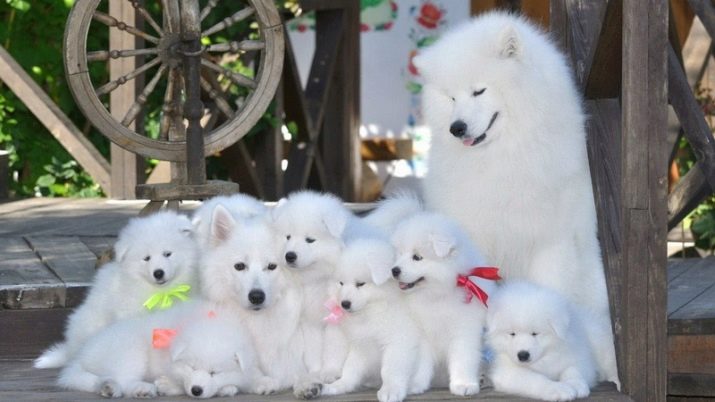
A Samoyed boy can be called Cosmos, Old, Prime, Grand, Bright, Titan, Atlanta, Boeing. Playful and mischievous puppies are often given the following nicknames: Tyson, Fight, Game, Play, Fly, Casper, Charlie, Dexter, Joy, Brave.
Nicknames that are consonant with the names of ancient deities and mythical characters are suitable for dogs of this breed. As examples here are the following options: Zeus, Hermes, Mars, Uranus, Hercules, Argo, Pegasus, Sphinx, Orpheus, Hephaestus, Theseus, Jason. Samoyed girls are suitable for the following names from the proposed theme: Nymph, Venus, Athena, Hera, Vesta, Diana, Shakti, Ariadne, Medea, Callipso.
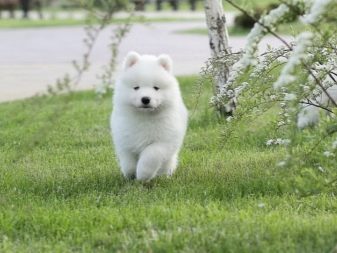
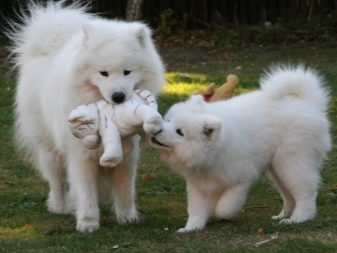
Very often Samoyed Laikas are called beautiful and euphonious foreign names. The most popular options here are nicknames for boy puppies: Charlie (Charles), Archie (Archibald), Arthur, Oscar, Tyler, Gordon, Jamie, Jakey, Dexter, Ryan, Edward. For puppies girls, the following names are often chosen: Gerda, Greta, Margot, Berta, Emma, Adele, Britney, Evie, Grace, Amelie, Alice, Rose, Darcy, Xena, Giselle, Chloe, Heidi, Aisha, Ivory, Ivette, Vega ...
Very popular among dog breeders and nicknames associated with the world of secular fashion and the attributes of glamorous life. As examples here you can cite such variants of names as: Versace, Prada, Tiffany, Gucci, Dior, Cartier, Cardin, Chanel, Dolce, Chloe, Birkin, Rolex, Bentley. Such nicknames also sound original: Snoopy, Bambi, Shanti, Pretty, Darcy.

Content
It is preferable to keep a Samoyed husky in an aviary, but in no case on a chain. The animal will also feel great in a private house with a small lawn and a closed yard for walking.
Keeping Samoyeds in the apartment is also allowed. However, it is important to consider here that these hyperactive and active animals will need regular and long walks. Small puppies initially will not experience inconvenience when kept in an apartment, but over time, their need for movement and physical activity will begin to increase.
If the dog is supposed to be kept in an aviary, it is important to consider that this structure must be strong. The mobile, physically powerful and strong Samoyeds are able not only to easily break a fragile door and break the net, but also to dig a tunnel and even jump over the high wall of the enclosure.
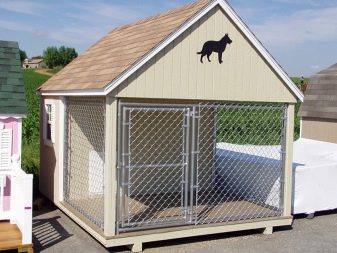
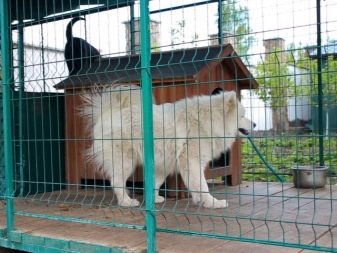
Thick and lush coat does not allow Samoyeds to freeze even in very cold weather. However, in summer these dogs should be protected from abundant sun and heat, which can cause heatstroke. In case of hot and sunny days, there must be a shelter in the aviary, in the shade of which the dog can hide.
Nutrition
Many Samoyed owners claim that these animals are not too pretentious about food. However, for full development and physical activity, they need a balanced diet rich in vitamins and microelements.Specialized dry feeds from well-known manufacturing companies are capable of providing this. Professional Samoyed breeders recommend Bosch, Belcando, Diamond brands.


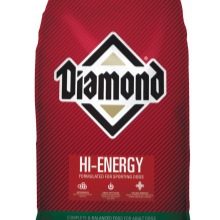
If the Samoyed diet is planned to be based on natural food, the owner should consider what foods and in what form should be offered to the pet. So, the list of permitted foods recommended for the daily diet includes the following:
- beef, ground beef;
- chicken, turkey;
- offal (beef heart, lungs, chicken stomachs and chicken heart);
- oceanic and marine lean fish;
- buckwheat and rice porridge;
- fermented milk products (kefir, low-fat cottage cheese, fermented baked milk, varenets);
- goat's milk and goat's milk curd.
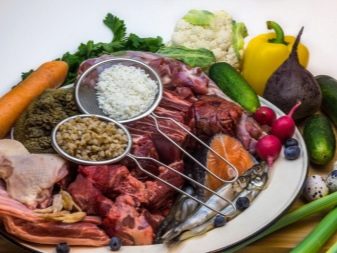
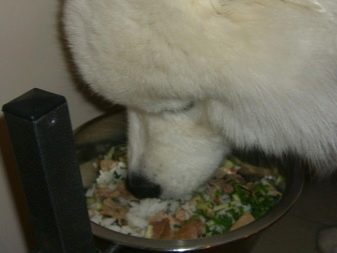
It is allowed to dilute the Samoyed diet with vegetables - cauliflower, Chinese and white cabbage, zucchini, cucumbers, bell peppers. Some dogs of this breed are very fond of fruits, from which they can be given apples, bananas and pears. Vegetables and fruits are introduced into the diet of animals carefully, monitoring the reaction of the pet's body in order to avoid allergies or digestive problems.
Experienced dog breeders remind that a diet consisting of natural feed must be supplemented with vitamin and mineral complexes. Sweets, spices and spices, bones, fatty meats are strictly not allowed in the dog's diet. It is also not allowed to give animals beets and potatoes.
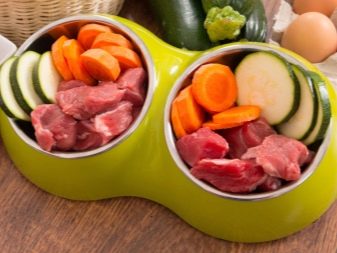

Feed your pet at the same time. The frequency and amount of feedings depend on the age and individual characteristics of the dog (weight, build, daily activity).
Hygiene
Samoyed huskies do not require specific care, but their thick and fluffy coat needs constant brushing and combing. It is advisable to carry out these procedures daily, preventing the formation of tangles.
During the molting period, the animals are combed out with a special wire brush. Such a tool copes well with lost hair, prevents it from falling into lumps.
Dogs of this breed do not need frequent washing. According to the breeders, it is enough to bathe Samoyeds 1-2 times a year. To allow the animal to dry faster after bathing, it is allowed to use a hairdryer (provided that the dog is not afraid of it).


To make the Samoyed coat look flawless after bathing, it is recommended to use special lightening zooshampoos and conditioners. Zoo shampoo will enhance the shining whiteness of the coat, while conditioner will make it easier to comb.
There is practically no need to trim the nails if the dog walks a lot and often. During walks, the Samoyed's nails are grinded down to the optimal length.
After walking, it is advisable to inspect the pet's paws every time. Given that these dogs are very active on walks and move a lot, there is often a risk of injury to the pads of the paws. If wounds, abrasions or cuts are found on the pads, it is necessary to treat the damaged area with hydrogen peroxide, and then lubricate with fucorcin.
Samoyed paws should be washed after each walk. This simple hygiene procedure will help protect your dog's paws from harmful chemicals in winter and clean them of dust and dirt in summer.

In addition, washing the paws can significantly reduce the risk of contracting various diseases, the pathogens of which the pet can bring from a walk.
Many owners of huskies, trying to make life easier for pets in extreme heat, cut and even shave their wards. According to experienced dog breeders, Samoyed Laikas should not be shaved. After such a procedure, the animals become even more susceptible to high temperatures, since the wool serves as a kind of thermal insulation for them. In addition, it was noticed that shaving negatively affects the condition of the animal's coat in the future: it grows more slowly, and its structure becomes much worse.
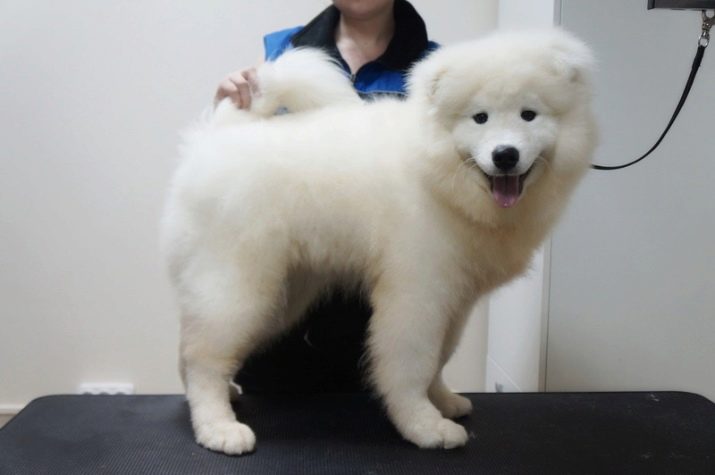
Training
Samoyeds are very trainable.This is facilitated by their natural intelligence, curiosity and good memory. Even without the knowledge of a professional trainer, any persistent owner can teach his pet a number of simple commands.
Training and education of the animal must be started from puppyhood. It is much more difficult to teach an adult animal the necessary commands. To a greater extent, the situation is aggravated in cases where an adult dog tries to take a dominant position or ignores the owner.

The list of basic commands that a Samoyed owner can teach a pet on their own includes such as "Come to me", "Sit", "Lie down", "Fu". The correct execution of the master's commands during training is recommended to be encouraged with a delicacy. As a treat, professional breeders recommend using boiled chicken hearts, cut into small pieces, slices of hard cheese or pieces of boiled beef liver, dried in the oven.
At the age of 3 months, a Samoyed Laika puppy must be enrolled in a general training course. Under the guidance of an experienced instructor, the dog will quickly learn to follow an extensive list of special commands, including those given to the animal through gestures.


Samoyed husky education and training should be combined with sports training. Dogs of this breed need intense physical activity, which strengthens the muscles of the animal, develop endurance, and have a beneficial effect on the neuropsychic state.
While training the Samoyed Laika yourself, you must adhere to the general recommendations related to the upbringing and training of the dog. TSo, commands should be given in a calm, even, strict and confident voice. Shouting, threatening or, conversely, overly affectionate intonation is not allowed. It is strictly forbidden to use brute physical force.
If the animal is tired, the training must be interrupted. During breaks with your pet, you can play ball or give the dog the opportunity to rest and gain strength.


Exercise should be regular, but not exhausting. If they give the animal uncomfortable sensations, the pet will become more reluctant to follow the commands, and over time it may begin to avoid training.
Owner reviews
As evidenced by the reviews of the owners of this breed of dogs, Samoyeds are unusually charming, charismatic creatures with a bright character. Their unique features are quick wit, curiosity, good memory, ability to learn quickly. The gentle nature of the Samoyed Laikas allows them to easily get along with other pets, find a common language with children and others.
However, the keeping of dogs of this breed has its own specific characteristics. All those who dream of having a Samoyed should take into account that this dog is primarily a companion. Samoyeds do not tolerate loneliness very badly, they need master's attention and love. You won't be bored with such a dog, so a sociable and benevolent person who leads an active lifestyle can become the best owner for a Samoyed.

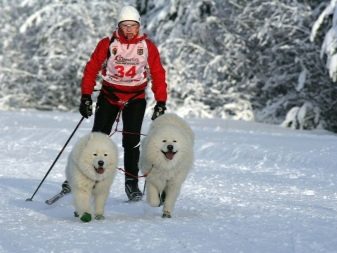
Despite their good-natured nature, many Samoyeds are very jealous. In the struggle for the attention of the owner, they may try to press the rest of the family members.
When planning to purchase a dog of this breed, it is important to take into account that its luxurious appearance is the result of competent and tireless grooming. The fluffy coat of the Samoyeds can get lost in untidy mats and lumps, causing the animal inconvenience and discomfort. The future owner should be prepared for the fact that he will have to devote a lot of time to combing the wool. However, the results of the work will invariably exceed all expectations.
It is difficult to imagine a more loyal and intelligent animal capable of competing with the Samoyed. This dog can make any weekday bright, charge with positive, give a lot of joyful and positive emotions. A person who decides to become the owner of this unique breed will never regret his choice.

For information on how to keep a Samoyed at home, see the next video.






































